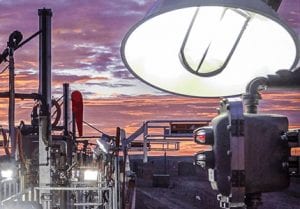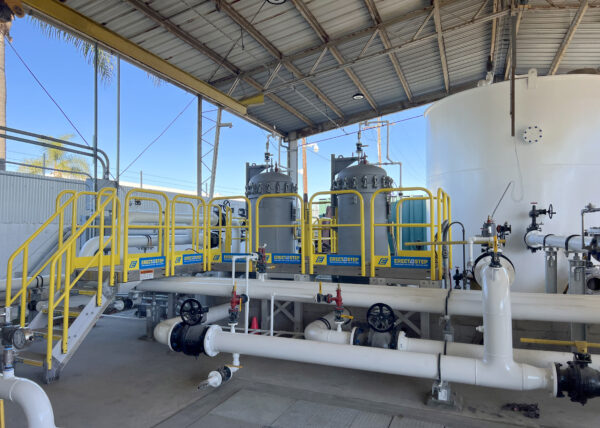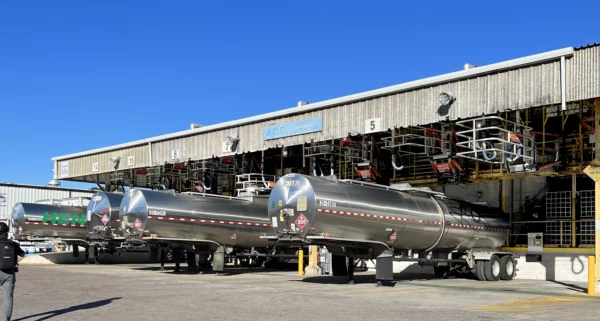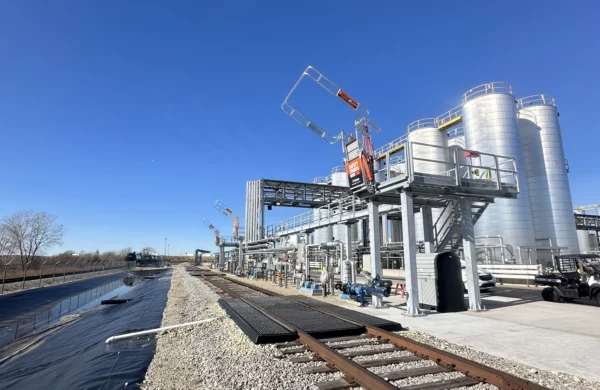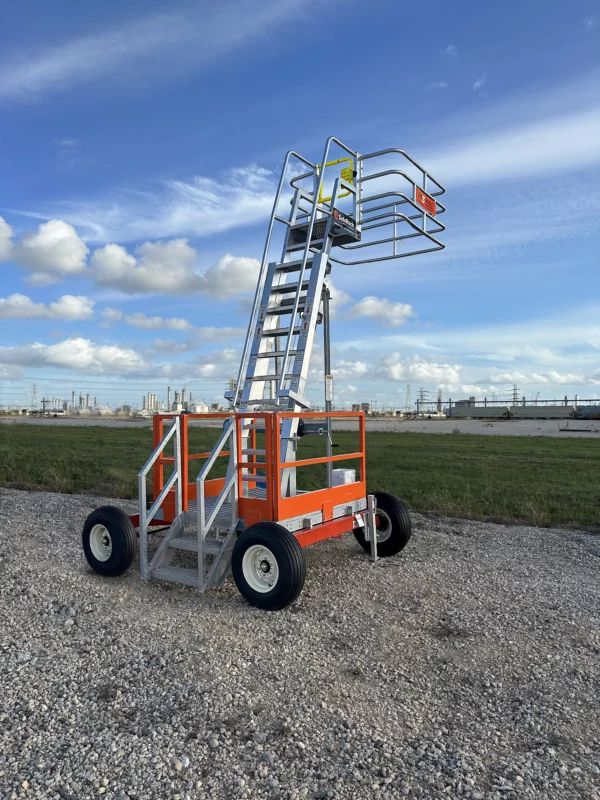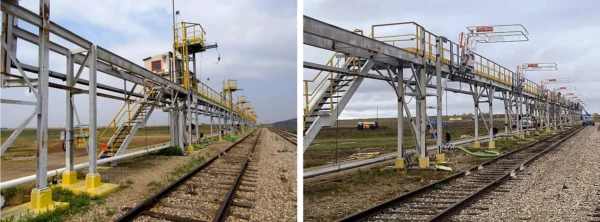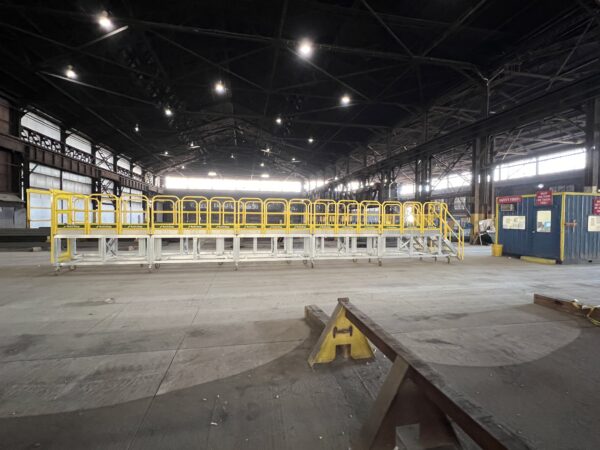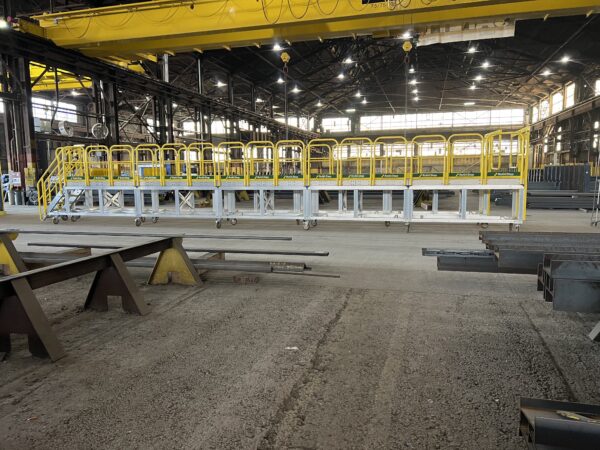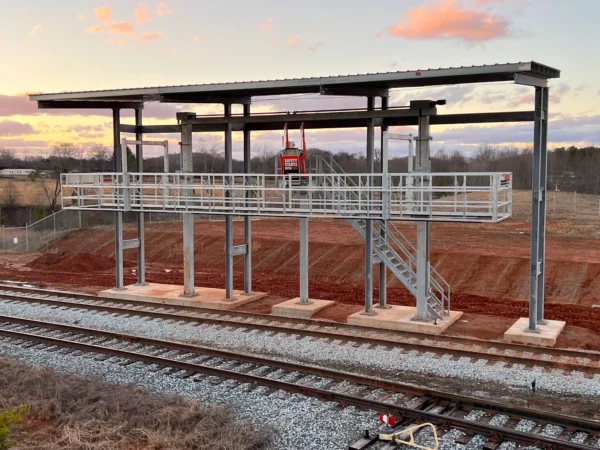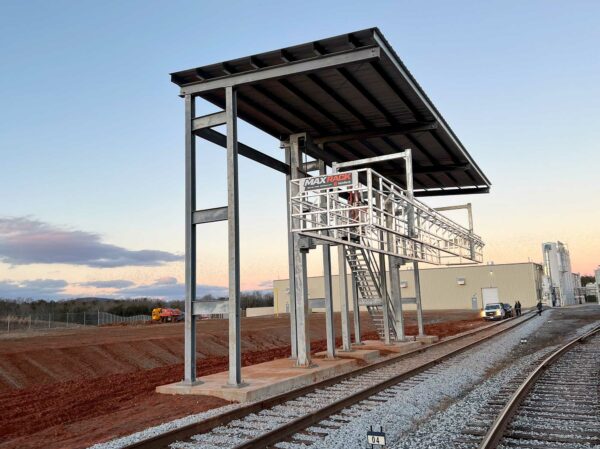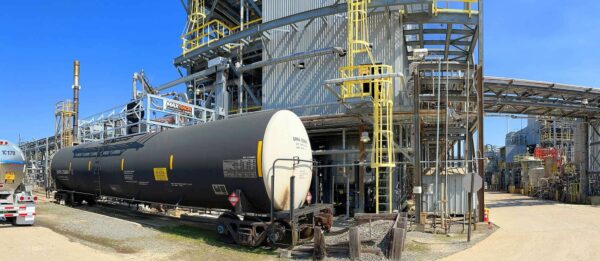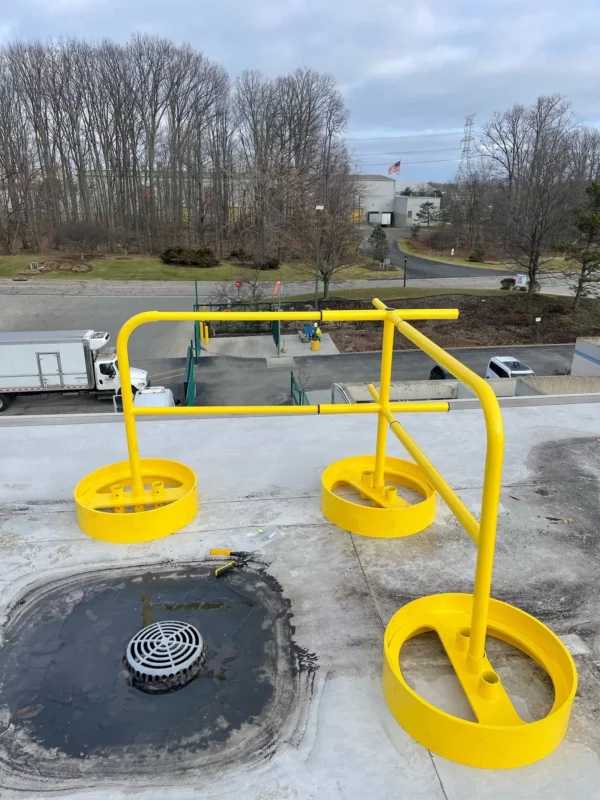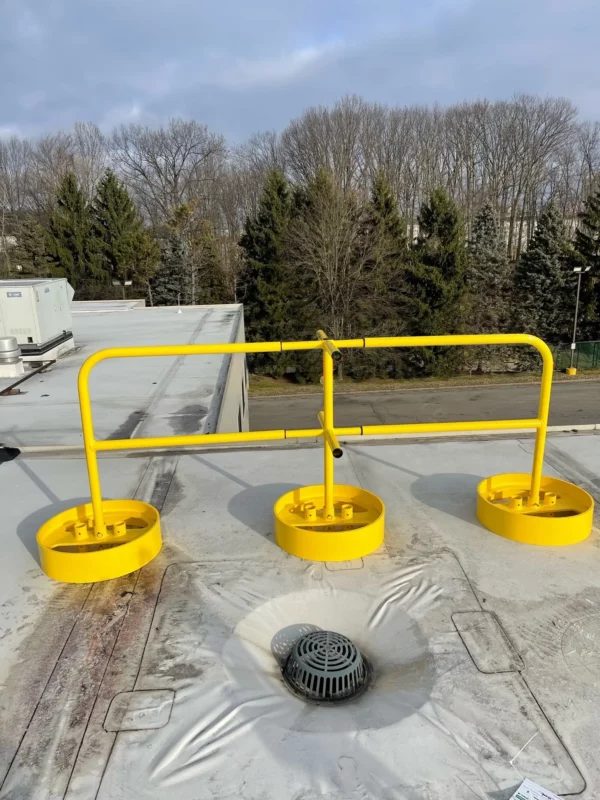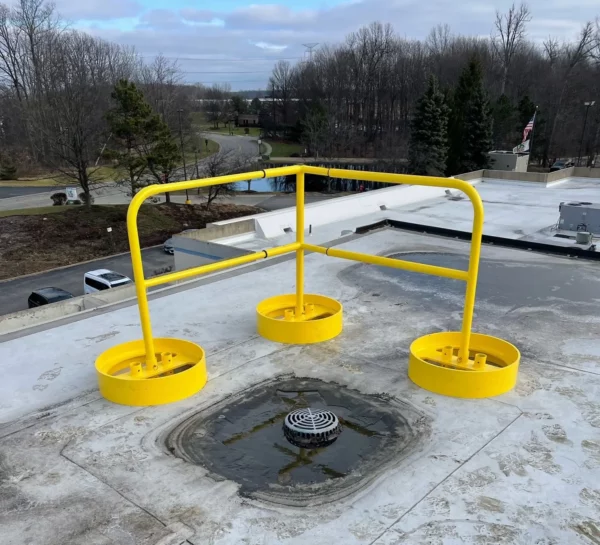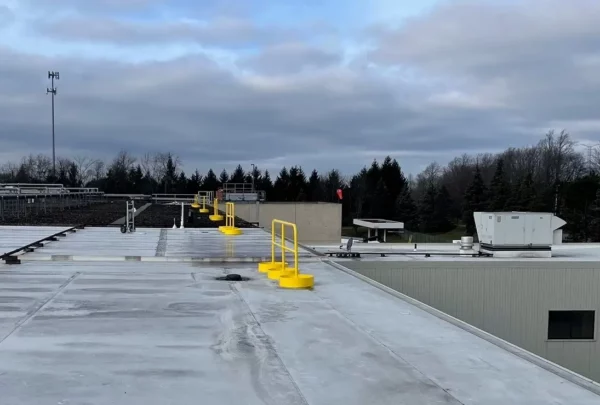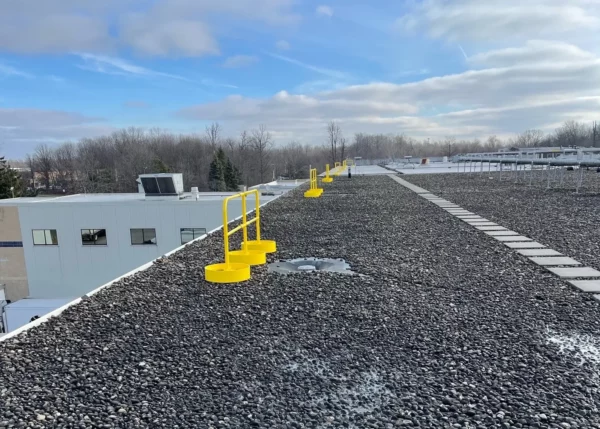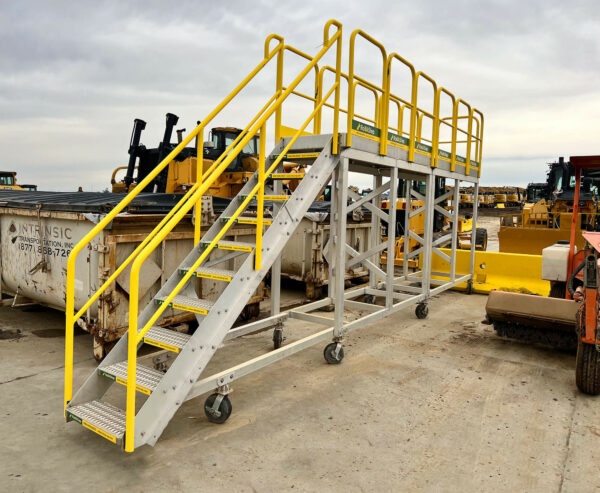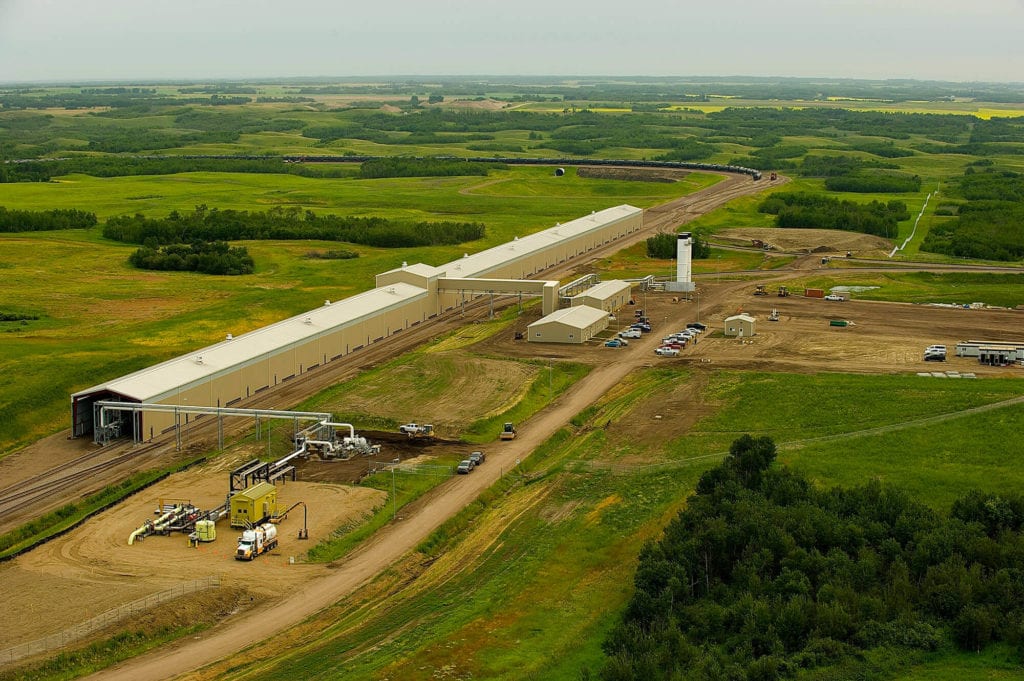Get a quote, configure a custom safety solution or ask a question. We're here to help!








- Spill ContainmentMore …Loading Safety CagesMore …
SafeRack Worldwide
We pride ourselves on one-on-one customer service. When you call SafeRack, we'll be there to answer your questions with a combined experience of 400+ years.
Select your region below.- View Products
- Railcar & Truck Loading Platforms
- Gangways & Loading Ramps
- Stairs, Platforms & Ladders
- Mobile Ladders & Platforms
- Loading Arms & Fluid Transfer
- Safety Gates & Traffic Control
- Aviation & Aerospace Access
- Marine Access & Loading
- Grounding & Monitoring
- Spill Containment
- Loading Safety Cages
- Transloaders & Skids
- Shelters & Canopies
- Fall Protection
- Terminal & Speciality
Home / Industries / Bulk Chemical Loading / Methyl IsocyanateMethyl Isocyanate Handling Design, Loading, and Installation.
Although no two Methyl isocyanate loading solutions will be identical, the product itself determines much of the critical design criteria that will ensure that optimum safety and productivity can work together in harmony.
What is Methyl Isocyanate? Methyl isocyanate or MIC is a flammable, colorless liquid with a strong odor. It’s used in the production of pesticides, polyurethane foam, and plastics. It’s typically transported and handled in a liquid state and is highly flammable and explosive.
In the United States, MIC is typically a “tight-fill” (closed-loop) loading operation and is loaded into rail cars via chemical hoses or 3” stainless steel loading arms. Methyl isocyanate, if not handled properly can cause serious injuries and Personal Protective Equipment (PPE) is required. Additionally, because operators are on top of the vehicles during the loading process, fall prevention is essential, not only for safety but increases throughput.
Methyl isocyanate is typically shipped in DOT-115 insulated tank cars with safety valves that meet the DOT specification for the transportation of MIC and other similar commodities. The rails cars themselves are ~ 9′ outside diameter with an overall length of ~45’ to 60′, with a 6’ x 6’ center opening or off-set opening crash box
Trailers are top unloaded. An extension pipe with two valves is flanged to the top of the trailer. One valve is located at the top, and the other is at the end of the pipe on the bottom for easy access. Trailers should arrive on-site with blind flanges.
All trailers must be equipped with pressure relief valves; and trailers with bottom outlets must be equipped with remote-controlled stop valves. Tank truck (un)loading procedures are similar to railcar applications with the trailers meeting established DOT requirements for hauling MMA or similar cargo. Approved DOT trailers include MC 300 thru MC 312, MC 330, and MC 331.








Question, Get a Quote, Live Demo or Request an On-Site Visit
Our experts simplify the complex
View Full TextTypical Methyl Isocyanate Loading Platform
Quote or discuss your installation.
Start by selecting loading application"*" indicates required fields
Below are some of the loading and unloading solutions for illustrative purposes only. Our experts will work with you and your team for a custom solution to suit your needs.
Methyl Isocyanate Loading Arms
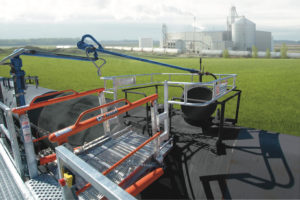
Methyl isocyanate is typically loaded into railcars or tank trucks via boom supported stainless steel loading arms or chemical hoses with a flange connection. The arm or hose will have a top inlet with a control valve to ensure that it is self-draining after use and is supported along the length of a mechanical loading arm to improve handling; this is known as a by-pass arm. You can install one liquid and one vapor arm, or mount both the liquid and vapor hoses on one by-pass arm. For unloading, typically you would use a rigid stainless steel self-draining loading arm with Kalrez, ChemRaz (FFKM) or PTFE seals. Purge lines can be fitted to the arm, for nitrogen purging. Additional features such as parking latches with proximity sensors can be incorporated into the total system to ensure the arm is correctly stowed when not in use, before any rail movement can occur.
Note: unloading hoses must be replaced annually to ensure their integrity.
Loading Gangways and Safety Cages

A wider access gangway (48″-60″ is preferable) as it helps improve access and egress to and from the vessel. In addition, a wider gangway will reduce the risk of the operator’s PPE getting caught, torn or damaged, and will improve productivity and safety. Powered gangway solutions are also an option, with both hydraulic and pneumatic solutions being commonly used. Each gangway will be fitted with a two-rail safety cage for the railcar crash box. This will be a centered 6’x6’ or 7’x8’ safety cage to sit directly over the cashbox. This will provide a safe, secure work environment for your operator when connected to their breathing apparatus.

SafeRack’s GX SAS gangways use Retractalok power-assist technology allowing operators to raise or lower effortlessly, light as a feather to lift, and solid as a rock. Tested in the most critical applications, this revolutionary new gangway outperforms all others. Available in multiple lengths and widths.
Learn MoreMAXRack Elevating Safety Cage
 As an alternative to our two and four-rail safety cages, some customers prefer our MAXRack elevating safety cages. The ultimate fall prevention solution engineered to keep operators safe and productive. Designed for both trucks or railcars, and available in multiple cage lengths and widths. Safe, durable, and easy to use. MAXRack is built rock-solid with galvanized steel column supports and lifting arms (cages can be Aluminum, Galvanized, or Stainless Steel depending on application) Available in two power options – Pneumatic Air Drive and Electric Drive (Explosion and Non-Explosion Proof).
As an alternative to our two and four-rail safety cages, some customers prefer our MAXRack elevating safety cages. The ultimate fall prevention solution engineered to keep operators safe and productive. Designed for both trucks or railcars, and available in multiple cage lengths and widths. Safe, durable, and easy to use. MAXRack is built rock-solid with galvanized steel column supports and lifting arms (cages can be Aluminum, Galvanized, or Stainless Steel depending on application) Available in two power options – Pneumatic Air Drive and Electric Drive (Explosion and Non-Explosion Proof).
Learn MoreMethyl Isocyanate Eye Wash/Drench Showers

ANSI guidelines state that an Eye Wash/Drench Showers need to be located 10 seconds or 55’ (16.8m) from contaminants or hazardous materials. Eyewash stations need to be on the same horizontal plane with no obstructions.
Therefore, we would propose the installation of a standard combination Drench Shower/Eyewash Unit, which will save limited space and fit easily into any work environment.
Methyl Isocyanate Spill Containment

Spill containment pans will be provided at the point of loading operations and is an essential piece of equipment in overall site safety and environmental protection. Methyl Isocyanate Grounding

Methyl Methacrylate is a flammable liquid and vapor. Industry best practice includes the grounding of all vessels before starting the (un)loading process. - Ground controllers — ensure true grounding before product flow is permitted
- Explosion-proof enclosures — meet or exceed UL, CSA, and Ex requirements
- Always use non-sparking tools when handling MIC.
Methyl Isocyanate Safety Gates

Safety gates are installed at the top of stairs and to protect openings to ensure operator and visitor safety at all times.  YellowGate Safety Gates
YellowGate Safety GatesOur industrial safety gates are the most flexible on the market. With the ability to span openings between 16″ and 36″, they are field adjustable and can be modified using nothing more than a wrench. Learn More
Methyl Isocyanate Options

- Lighting – For overcast days or second shifts, lighting is essential for improved safety and improved productivity on and around the loading platform.
- Platform & Canopies – Full platform canopies reduce exposure to the elements and improve safe and productive loading operations.
- Operator Shelter – Site requirements may call for an operator or guard building on the loading platform. This can be customized to meet site specifications.
- Wheel Chocks – Required by the Department of Homeland Security, railcar wheel chocks provide fast blocking of all types of railcars and meet OSHA regulations to safely prevent railroad cars from moving during loading or unloading operations.
Personal Protective Equipment PPE Requirements
Eye/Face Protection: Wear chemical safety goggles. A face shield (with safety goggles) may also be necessary.
Skin Protection: Wear chemical protective clothing e.g. gloves, aprons, boots. Coveralls or long sleeve shirts and pants in some operations. Wear a chemical protective, full-body encapsulating suit, and self-contained breathing apparatus (SCBA). Suitable materials include: Barrier® – PE/PA/PE, Silver Shield® – PE/EVAL/PE, Trellchem® HPS, Trellchem® VPS, Saranex®™, Tychem® BR/LV, Tychem® Responder® CSM, Tychem® TK.
Respiratory Protection: Up to 5 ppm:
(APF = 10) Any chemical cartridge respirator with cartridge(s) providing protection against chlorine*; or any supplied-air respirator*.
*Reported to cause eye irritation or damage; may require eye protection.
APF = Assigned Protection Factor
Recommendations apply only to National Institute for Occupational Safety and Health (NIOSH) approved respirators. Refer to the NIOSH pocket guide to chemical hazards for more information.
Use a local exhaust ventilation and enclosure, if necessary, to control the amount in the air. Consider using a corrosion-resistant exhaust ventilation system separate from other ventilation systems. It may be necessary to use stringent control measures such as process enclosure to prevent product release into the workplace. Use backup controls (e.g. double mechanical pump seals) to prevent the release of this material due to equipment failure. Customer Reviews
 5 5Your range of products is very useful and high quality.
5 5Your range of products is very useful and high quality.Your range of products is very useful and high quality that is easy to use, easy to install and uninstall, and easy to transport because it can split to part by part. I would recommend your ErectAStep product because we can add more parts to change the configuration, height and width compared with other products.
By Amran Mat Zanggi from OGCF Engineering (M) SDN BHD on 10/2/14 5 5We love it when our vendors make sure that what we want is exactly what is need.
5 5We love it when our vendors make sure that what we want is exactly what is need.Cost is always a consideration. We look for alternatives, but the quality of your products and the service balances the scales. We received exactly what we ordered. SafeRack also assisted in making sure we knew what was needed and asked questions we had not taken into consideration. SafeRack actually is better at making sure we know what is needed when we only request a product. It is appreciated when the vendor makes sure what we want is exactly what is needed.
By Jerry Hilgendorf from NuStar Logistics, L.P. on 8/8/12 5 5It took longer for us to issue the PO than it did to get the product!
5 5It took longer for us to issue the PO than it did to get the product!Jason is our Super Hero. We call him Captain America… he’s great! It took longer for us to issue the PO than it did to get the product! Thanks again!
By Troy McCrery from L-3 Communications on 4/24/12 5 5SafeRack is already a recognized leader in the industry.
5 5SafeRack is already a recognized leader in the industry.SafeRack is already a recognized leader in the industry. The product was delivered quick considering the location of our site. The design fits with our needs and allows our workers to work in a safe environment. Overall, customer service could work on communication between sales reps, engineering drawings and specs were easily accessible, the product quality is good so far, delivery was on time and packaging was great with no damage. Pricing is a bit above the competition but you’re paying for quality.
By Cedric Boivin from Orica Canada Inc. on 7/7/16 4 5Service was top notch!
4 5Service was top notch!Service was top notch! I’m very pleased with the overall customer service. Linda Hardee was very helpful and punctual.
By Verne Elledge from O'keeffe's on 2/14/12 5 5My experience with my salesman was excellent.
5 5My experience with my salesman was excellent.All personnel that I dealt with when sourcing this product, to purchasing and delivery, were highly professional and a pleasure to deal with. The order was placed August 9th and received at our office August 16th as scheduled. My experience with my salesman was excellent. When I was making inquiries on this product, he happened to be in town and a meeting was set up the next day, which provided many answers to my questions. The unit has yet to be installed, but the construction and available ports for electrical connections will make the unit very adaptable for our application. Based on the service from SafeRack and the specification ratings required for our hazardous ratings applications, I would highly recommend this product.
By Bob Fleming from Wareham and Crowe Electric on 8/29/16SUCCESSFUL METHYL ISOCYANATE LOADING PROJECTS
Methyl Isocyanate 101
Things to know about Methyl Isocyanate
Methyl isocyanate is regulated by the U.S. Department of Transportation (DOT) and is classified as a corrosive and flammable liquid with the DOT identification number UN 2480.
MIC is a volatile, colorless liquid that is extremely flammable and potentially explosive when mixed with air. MIC also has a strong reaction with water, giving off heat and producing methylamine and carbon dioxide. Vapors are toxic if inhaled, ingested, or exposed to the eyes or skin.
Methyl isocyanate is used as a chemical intermediate in the production of carbamate insecticides, and herbicides and in the production of polyurethane foam board and plastics.
Best practice for handling this chemical includes wearing chemical-resistant clothing, gloves, goggles, and/or a respirator.
MIC causes serious eye irritation and may cause an allergic skin reaction as well as respiratory irritation. Can be fatal if inhaled; avoid breathing dust, fumes, gas, mist, or vapors. If inhaled, remove the victim to fresh air and call the poison center. Do not induce vomiting, clean the victim’s mouth with water and seek medical attention.
MIC is a highly flammable liquid and vapors may form explosive mixtures with air, so extreme care should be taken when handling this product. In the event of a spill or leak, exit the area immediately.
Eliminate heat and ignition sources such as sparks, open flames, hot surfaces, and static discharge. Post “No Smoking” signs. Released vapors may travel to the source of ignition and flash back. Therefore it’s important to eliminate all sources of ignition, and take precautionary measures against static discharges.
Only properly trained and equipped personnel should be permitted to unload railcars or tank trucks. Operators should wear an approved respiratory protective device, and impervious clothing, footwear, gloves, and goggles.
OSHA Permissible Exposure Limits (PEL) @ 2 ppm in an 8-hour day.
MIC is not compatible with aluminum, carbon, or galvanized steel, so great care should be taken to avoid contact with these materials. However, nickel, stainless steel, and glass or ceramic are rated acceptable when working with this chemical. Methyl isocyanate will attack most elastomers, but fluorocarbon resins are resistant.

Is your plant or facility compliant with ANSI, OSHA, and local safety codes? We can help!


EMERGENCY EYEWASHES / SHOWER EQUIPMENT AND THE ANSI/ISEA Z358.1 – 2014 STANDARD
Following eye contact, you must start washing with water immediately to prevent permanent damage. In the event of skin contact, you must start washing with water immediately to prevent slow-healing chemical burns.
Are you aware that ANSI guidelines state that Eye Wash/Drench Showers need to be located 10 seconds or 55′ from contaminates or hazardous materials and located on the same horizontal plane, with no obstructions? If bottom loading/unloading, an additional shower should be located at grade as well. SafeRack provides the above equipment plus much more needed to keep employees safe and expedite bulk chemical loading and unloading.
OSHA Regulation Experts – Does your existing chemical safety equipment or chemical loading systems meet OSHA’s latest requirements? SafeRack’s professional technical sales consultants are available to meet with your team to make recommendations to keep your facility in front of OSHA’s ever-changing country and region-specific standards and regulations, including lifeline and trolley beam fall arrest systems, metal stairs, and access platforms.
Why SafeRack?
The SafeRack approach is a collaborative one. Let’s call it The SafeRack Way. We have, over many years amassed a great deal of experience and understanding of the safety aspects involved in loading road tankers and railcars, as well as the behavioral habits of the operators.

Experts In Chemical Loading
- Acetic Acid
- Acetic Anhydride
- Acetonitrile
- Acrolein
- Acrylic Acid
- Acrylonitrile
- Aluminum Chloride
- Aluminum Sulfate
- Ammonia
- Ammonium Hydroxide
- Ammonium Nitrate
- Aniline
- Benzene
- Benzyl Chloride
- Bromotrifluoromethane
- Butadiene
- Carbon Dioxide
- Caustic
- Chlorine
- Chloroform
- Chlorosulfonic Acid
- DEF (Diesel Exhaust Fluid)
- Diethylene Glycol
- Dimethylformamide
- Dodecylbenzene Sulfonic Acid
- Ethanol
- Ethyl Acetate
- Ethyl Chloride
- Ethylene
- Ethylene Dichloride
- Ethylene Glycol
- Ethylene Oxide
- Ferric Chloride
- Ferrous Chloride
- Hexane
- Hydrochloric Acid
- Hydrofluoric Acid
- Hydrofluorosilicic Acid
- Hydrogen Cyanide
- Hydrogen Peroxide
- Hydrofluoric Acid
- Hypochlorous Acid
- Isopropyl Acetate
- Liquid Argon
- Liquid Nitrogen
- Liquid Oxygen
- Maleic Anhydride
- MDI
- Methanol
- Methyl Chloride
- Methyl Ethyl Ketone
- Methyl Methacrylate
- Methyl Isocyanate
- Molten Sulphur
- Nitric Acid
- Oleum
- Phenol
- Phosphoric Acid
- Phosphorus Oxychloride
- Phosphorus Trichloride
- Polypropylene
- Renewable Diesel
- Sodium Cyanide
- Sodium Hydroxide
- Sodium Hypochlorite
- Styrene Monomer
- Sulfuric Acid
- Sulfur Dioxide
- Titanium Tetrachloride
- Toluene
- Toluene Diisocyanate
- Turpenitne
- UAN (Urea Ammonium Nitrate)
- UREA
- Vinyl Acetate
- Vinyl Chloride
- Xylene
- Zinc Chloride
- Agro-Chemical
- Specialty Chemical
- Petrochemical

North America’s largest loading terminal
World-leading designer, manufacturer, and installer of truck and railcar loading platforms
As one of the primary railcar loading points, Hardisty is one of the major crude oil hubs in North America and a major origination point of pipelines that export to the United States. SCS was asked to supply and construct a SafeRack crude oil loadout terminal spanning nearly half a mile. The USD Hardisty terminal can load up to two 120-railcar unit trains per day and consists of a fixed loading rack with 62 railcar loading positions enclosed, separate control, operator, and mechanical buildings, as well as a unit train staging area and loop tracks capable of holding multiple unit trains simultaneously. SCS also supplied and installed boom-supported loading arms with supply and vapor management systems.

Quick Quote 866-761-7225
LET US DESIGN YOUR SOLUTION TODAY
Our innovative tools provide 3D visualizations and accurate quotes in minutes.
Get Help NowOrder Now 866-761-7225
Questions or Need a Quote?
Chat live with a knowledgeable and friendly safety expert now.

Bob Kashtan
Located in South Carolina

Joey Robinson
Located in South Carolina

Caelin Lacy
Located in South Carolina

Katie Kelly
Located in South Carolina

Amber Graham
Located in South Carolina















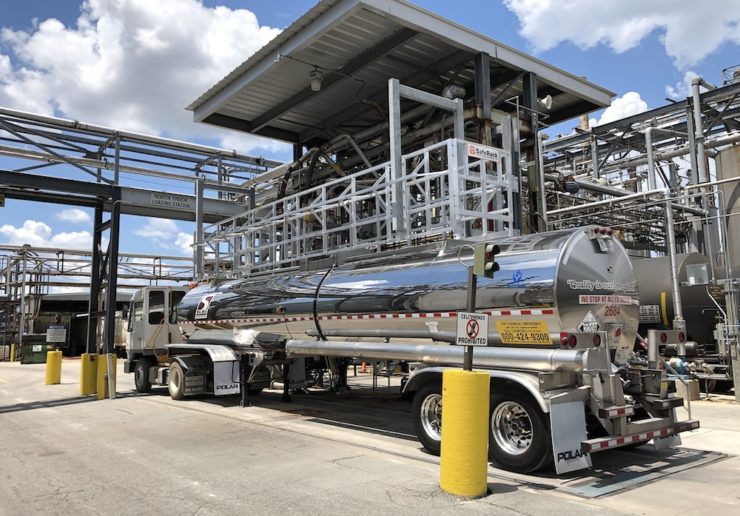



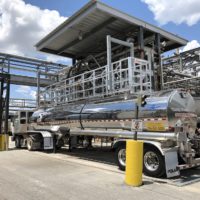

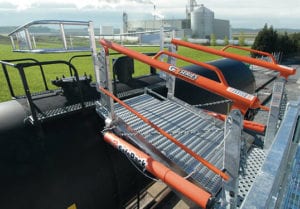
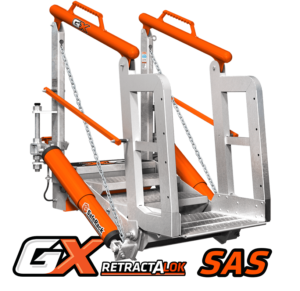
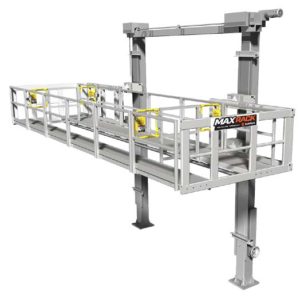 As an alternative to our two and four-rail safety cages, some customers prefer our MAXRack elevating safety cages. The ultimate fall prevention solution engineered to keep operators safe and productive. Designed for both trucks or railcars, and available in multiple cage lengths and widths. Safe, durable, and easy to use. MAXRack is built rock-solid with galvanized steel column supports and lifting arms (cages can be Aluminum, Galvanized, or Stainless Steel depending on application) Available in two power options – Pneumatic Air Drive and Electric Drive (Explosion and Non-Explosion Proof).
As an alternative to our two and four-rail safety cages, some customers prefer our MAXRack elevating safety cages. The ultimate fall prevention solution engineered to keep operators safe and productive. Designed for both trucks or railcars, and available in multiple cage lengths and widths. Safe, durable, and easy to use. MAXRack is built rock-solid with galvanized steel column supports and lifting arms (cages can be Aluminum, Galvanized, or Stainless Steel depending on application) Available in two power options – Pneumatic Air Drive and Electric Drive (Explosion and Non-Explosion Proof).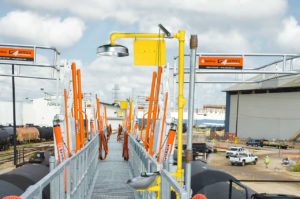
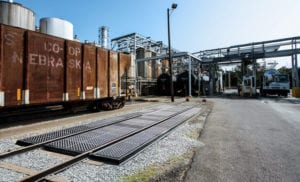
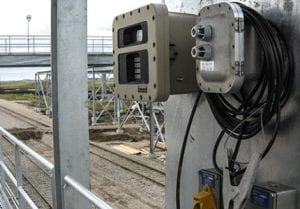
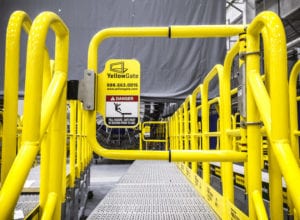
 YellowGate Safety Gates
YellowGate Safety Gates